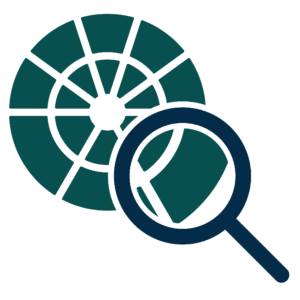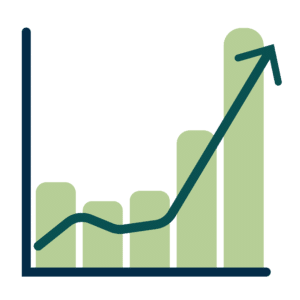Recent studies show that a mere 51% of companies have a succession plan in place, yet 70% of CEOs are considering resignation. Where does your organization stand?
The Importance of Succession Planning
Succession planning is the process of proactively developing reserve talent to seamlessly transition into critical leadership roles, ensuring the continuity of operational effectiveness when vacancies arise. Recent studies show that a mere 51% of companies have a succession plan in place1, yet “nearly 70% of the C-suite are seriously considering quitting for a job that better supports their well-being.”2 Sudden vacancies without a succession plan can quickly derail an otherwise thriving organization. Despite this, succession planning is often overlooked or neglected. As the saying goes, “those who fail to plan, plan to fail.
This guide is designed to demystify the process of succession planning, providing a simple yet scientifically grounded approach, enriched by expert insights from seasoned succession planning consultants with decades of experience supporting leadership transitions and development. Drawing from their collective wisdom, we’ll cover essential steps and best practices to help organizations of any size or complexity navigate succession planning effectively.
The Succession Planning Process
PHASE 1: FUTURE ROLE ANALYSIS
Appointing an advisory committee is a vital first step in the succession planning process. While typically considered a full board responsibility, the succession planning committee may also include HR professionals, executives, and external consultants. These committees benefit significantly from the inclusion of a professional succession planning consultant who can provide objectivity, mitigate emotionally charged decisions, and reduce biases. The integration of both internal and external perspectives creates a well-informed and balanced approach to succession planning that sets the stage for a smooth transition.
Begin by identifying which roles are critical to your organization’s success and sustainability. Prompts to consider when determining critical roles include:
-
-
- Impact on business operations: Consider to what extent a sudden and unexpected vacancy would create disruptions to core functions of your business, such as revenue generation.
-
-
-
- Knowledge base: Would an unanticipated vacancy leave a significant gap in knowledge or experience that would be difficult to replace?
-
By carefully evaluating these aspects, you can pinpoint which positions are essential to maintain your organization’s ongoing stability and success.
After identifying critical roles, consider how the organization’s strategic direction will likely impact these critical roles and what will be needed to adapt effectively. This forward-thinking approach ensures your succession plan remains relevant and dynamic, thereby preparing successors for both current and future challenges.
Based on the role’s previously identified needs, what skills, experience, competencies, and characteristics will statistically correlate with high performance and allow a successor to thrive in the position? By clearly defining your critical role success profiles, you ensure that only the most capable and compatible candidates are selected.
Success Profile Criteria Examples:
-
-
- Learning Agility: Absorbs and implements new knowledge in diverse situations; adapts the business to market shifts and drives change.
-
-
-
- Emotional Intelligence: Exhibits the ability to recognize, understand, and regulate one’s own emotions; applies this understanding to navigate interpersonal interactions constructively and enhance communication.
- Cultural Alignment: Values, behavior, and work style align to the core values and culture of the organization.
- Emotional Intelligence: Exhibits the ability to recognize, understand, and regulate one’s own emotions; applies this understanding to navigate interpersonal interactions constructively and enhance communication.
-
-
-
- Self-Awareness: Demonstrates understanding of one’s own strengths, weaknesses, and impact on others; applies this awareness to adjust to situations and to develop and grow.
-
-
-
- Forward-Thinking: Anticipates future trends and challenges; plans strategically to keep the organization competitive.
-
PHASE 2: BUILD & ADMINISTER ASSESSMENT
A structured talent assessment process is key to identifying individuals who not only fit the current requirements but also have the potential to evolve with the role. This process should begin with a preliminary interview to gauge a contender’s interest in the role, followed by customized assessment tools, which are selected based on the role’s success profile. The incorporation of specialized talent assessment tools can enrich your protocol by revealing data-driven insights into each contender’s unique competencies and potential. Depending on what aspects you’re aiming to assess, possible tools could include:
-
-
- Leadership Potential: Structured Interview and Leadership Self-Assessment
-
-
-
- Personality Characteristics: Hogan Personality Assessment
-
-
-
- Critical Thinking Skills: Watson-Glaser
-
A comprehensive talent assessment process ensures that candidates will be vetted thoroughly and systematically, providing the succession planning committee with a holistic and multi-faceted understanding of each contender.
Your talent search should always begin within. Hiring internally offers numerous advantages such as lower recruitment costs and candidates who are deeply familiar with the inner workings of your company. This approach also fosters a culture of employee loyalty and long-term retention. Begin by identifying internal talent with leadership potential and then administer the previously created assessment process to this pool of contenders, thereby pinpointing your most capable and compatible candidates.
Should the in-house assessment indicate a lack of suitable candidates, external recruitment may be necessary. Nevertheless, it’s imperative to maintain consistency in the evaluation process, ensuring a fair and comprehensive vetting process.
PHASE 3: SELECT & DEVELOP HIGH POTENTIALS
Your high potentials will be identified through your assessment process. Ideally, you’ll want to select 1-2 candidates for each critical position, based on which individuals demonstrated the highest potential combined with the fewest gaps based on your organization’s previously defined competencies and criteria.
The development plan, tailored to the role, timing, and individual, should address deficiencies and cultivate potential by aligning the role’s needs with the candidate’s assessment results. A succession planning coach or consultant can be especially helpful at this stage of the process. Their expertise in leadership development and facilitating growth greatly enhances the process and the efficacy of the development plan. The development plan should also delineate specific transition goals designed to facilitate knowledge transfer, thereby maximizing the incumbent leader’s time and influence.
The essence of preparing a successor lies in effectively implementing the development plan. Ideally, a period of at least 10 months should be allotted for candidate development, however, shorter timelines may be necessary for imminent transitions. During this critical phase, candidates should be immersed in skill-expanding and challenging projects that bear the risk of failure, offering them a chance to demonstrate resilience and capability under pressure.
360° Assessments, such as the Leadership Circle Profile™, can be extremely valuable as a talent development tool for upcoming successors to refine their leadership skills. The LCP is a comprehensive leadership assessment that incorporates both peer and personal feedback, increasing the leaders’ awareness of their impact on others, thus enabling them to make targeted adjustments that strengthen specific leadership competencies needed to be even more effective.
A pivotal part of a successor’s development involves mentorship under the incumbent leader, ensuring a seamless transfer of institutional knowledge essential for the role. Candidates should be given the opportunity to assume the incumbent’s duties, either in their absence or as part of a provisional leadership exercise, allowing them to experience the role’s responsibilities firsthand. Emphasizing hands-on involvement and decision-making opportunities with candidates not only enriches the learning process but also provides invaluable insights into how the candidate might handle the demands of the role if selected permanently, thereby informing the board’s eventual decision.
PHASE 4: ASSESS & SELECT INTO ROLE
Throughout the developmental journey, the succession planning committee should regularly meet to discuss each candidate’s progress, providing feedback and adjusting development strategies as needed. Only after a thorough review period, where candidates have had ample opportunity to demonstrate their capabilities and grow in their roles, does the committee move to the next step – appointing a successor.
This step involves synthesizing all the data, insights, and evaluations collected while monitoring the candidates’ development to make the most informed and strategic decision for the well-being of the organization. The committee conducts a comprehensive review of each candidate’s performance, evaluating how effectively they have realized their potential, performed under pressure, enhanced their leadership capability, bridged competency gaps, and evolved into a leader who embodies the role’s success profile. A data-driven selection will position your organization for sustained growth and longevity.
Succession planning is a critical investment in your organization’s long-term stability and success. By adhering to the succession planning process outlined in this guide, your organization will be well prepared to navigate leadership transitions effectively, whether expected or unexpected. This systematic approach ensures that you are not only identifying and nurturing the right talent, but also ensures your organization is future-ready, with capable successors that embody the success profiles that your organization needs to thrive.
Succession Planning Best Practices
Start Now
Succession planning is most effective when it’s an ongoing, forward-looking process, not a reactive solution to imminent leadership gaps. It’s never too early to have a plan in place. This proactive approach is emphasized by Leadership Circle’s Principal Consultant & Head of Coaching & Transformational Development, Cheryl Chantry:
“A deliberately developmental approach is about taking the long view and working well in advance of the moment of readiness to help leaders build deep awareness, self-authored character development, and the transformative shifts in identity that shape and elevate true potential.”
By planning well in advance, you ensure adequate time to source and develop a strong pipeline of high-potential talent who are prepared to step up when vacancies occur and drive the organization forward.
Embrace Transparency
Effective communication is key in succession planning – it should be timely, frequent, and, above all, honest. It’s important to foster open dialogue, normalizing succession planning as a fundamental aspect of organizational health. Furthermore, thoughtful and strategic messaging to the organization is crucial to ensure the incumbent leader’s exit is handled with grace and respect, setting a positive tone for the leadership transition.
Be Scientific
When it comes to succession planning, Industrial/Organizational Psychologist, Dr. Cybelle Lyon’s top advice is to follow a scientific approach. She emphasizes that candidate selection should be based on clearly defined criteria and needs, rather than subjective judgments:
“Be scientific about identifying what is needed and who has what is needed. Don’t rely on gut instincts, impressions, or simply on past performance alone. Be sure to do a job analysis and create a success profile. How can you hire who you need if you don’t know what you are seeking? I mean really know. In other words, you look for the competencies you know will matter statistically – not just your own biases.” ~ Cybelle Lyon, Ph.D.
This process will systematically reveal exactly what type of candidate is needed to succeed in key positions, laying a strong foundation for your organization’s continued success.
Succession Planning Tools & Services
Talent Assessment Tools
Free Leadership Self-Assessment
Leadership Circle’s Free Leadership Self-Assessment is a valuable succession planning tool that can be utilized as part of the assessment protocol, offering board members a unique opportunity to understand the leadership potential and deficiencies of candidates through self-reflective feedback. Upon completion of the self-assessment, participants are provided with a visual benchmark of their current leadership effectiveness against a global database, showcasing which areas need the most attention in order to foster effective leadership skills.
Talent Development Tools
Leadership Circle Profile™ 360° Assessment
Validated by the Institute for Psychological Research and Application (IPRA), the Leadership Circle Profile™ is a trusted leadership development tool, equipping organizations to shape high-potential candidates into capable, well-rounded leaders, ready to thrive in their new roles. The Leadership Circle Profile (LCP) not only measures key competencies but also behavior and thinking, enabling leaders to gain awareness of the underlying paradigms that influence their behavior. Unlike the free leadership self-assessment, which only gathers personal feedback, the LCP incorporates peer feedback to provide a comprehensive view of how a leader’s effectiveness is perceived (both internally and externally) and uncovers key areas for development.
Succession Planning Consulting
Leadership Circle®
Succession planning isn’t about mere role fulfillment, but rather cultivating future leaders who embody your organization’s core values and strategic vision. Our approach integrates cutting-edge 360° leadership assessments with a deep understanding of the factors that drive organizational success. Connect with our team of experienced consultants to prepare your organization for a seamless leadership transition.
Key Contributors
Cybelle Lyon, Ph.D
Dr. Cybelle Lyon is a seasoned Industrial/Organizational Psychologist with over 20 years’ experience in supporting leadership selection and development. Her extensive expertise includes succession planning, executive assessment, and executive coaching. She is skilled at designing selection systems, and high potential development programs. Known for her scientific and data-driven approach, Dr. Lyon has helped countless organizations navigate the complexity of succession planning, consistently achieving predictable and positive results.





